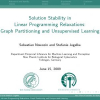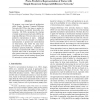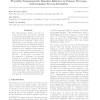ICML
2009
IEEE
15 years 3 months ago
2009
IEEE
Many machine learning algorithms can be formulated as a generalized eigenvalue problem. One major limitation of such formulation is that the generalized eigenvalue problem is comp...
ICML
2009
IEEE
15 years 3 months ago
2009
IEEE
The purpose of this paper is three-fold. First, we formalize and study a problem of learning probabilistic concepts in the recently proposed KWIK framework. We give details of an ...
ICML
2009
IEEE
15 years 3 months ago
2009
IEEE
ICML
2009
IEEE
15 years 3 months ago
2009
IEEE
We propose a new neural network architecture, called Simple Recurrent Temporal-Difference Networks (SR-TDNs), that learns to predict future observations in partially observable en...
ICML
2009
IEEE
15 years 3 months ago
2009
IEEE
Subgroup discovery is the task of identifying the top k patterns in a database with most significant deviation in the distribution of a target attribute Y . Subgroup discovery is ...
ICML
2009
IEEE
15 years 3 months ago
2009
IEEE
Semi-supervised learning (SSL), is classification where additional unlabeled data can be used to improve accuracy. Generative approaches are appealing in this situation, as a mode...
ICML
2009
IEEE
15 years 3 months ago
2009
IEEE
Similarity measures in many real applications generate indefinite similarity matrices. In this paper, we consider the problem of classification based on such indefinite similariti...
ICML
2009
IEEE
15 years 3 months ago
2009
IEEE
The inhomogeneous Poisson process is a point process that has varying intensity across its domain (usually time or space). For nonparametric Bayesian modeling, the Gaussian proces...
ICML
2009
IEEE
15 years 3 months ago
2009
IEEE
We describe an algorithm for constructing a set of acyclic conjunctive relational features by combining smaller conjunctive blocks. Unlike traditional level-wise approaches which ...
ICML
2009
IEEE
15 years 3 months ago
2009
IEEE



